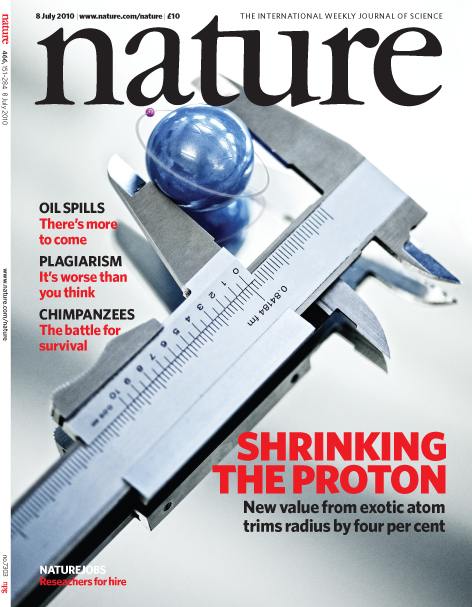The MUon proton Scattering Experiment (MUSE)
Until 2010, the radius of the proton was believed to be about
0.88 ± 0.01 fm
(10-15 m), from measurements using two techniques. First, there are precise
measurements of energy levels of atomic hydrogen, an atom with a proton nucleus and a
single electron orbiting it. The deviation of these levels from those
calculated with quantum mechanics for a point-like proton can be used
to determine the proton size. Second, one can shoot a beam of
electrons at protons. The probability of the electrons scattering
from the protons also depends on the proton size.

In 2010, measurements of energy levels of muonic hydrogen, an atom
with a proton nucleus and a single muon orbiting it, instead gave the
proton size as 0.842 ± 0.001 fm. The muon is essentially identical
to the electron, but 200 times heavier. As a result it orbits closer to
the proton, and can determine the proton size more precisely.
The collaboration published an improved, consistent result in 2013.
These matters are extensively discussed in a
Workshop on the Proton Radius Puzzle
in Trento, Italy in late 2012 and in a
review paper
by Pohl, Gilman, Miller, and Pachucki.
The inconsistency is now at about the 7σ level, and is
attracting a lot of attention.
The proton radius puzzle is being addressed by a number of new
experimental
efforts, including heavier muonic atoms, redoing the atomic hydrogen
measurements and redoing the electron scattering measurements to even
lower momentum transfer.
The MUon proton Scattering Experiment (MUSE) at the PSI πM1
beam line is an effort to expand the comparisons by determining
the proton radius through muon scattering, with simultaneous
electron scattering measurements.
The following documents are available:
- List
of collaboration members
-
Original proposal for February 2012
-
Proposal defense for February 2012
-
Original technical design report (TDR) for July 2012
-
TDR Review Committee Report
-
Report on the fall 2012 test run
-
Proposal update for January 2013
-
Proposal defense for January 2013
-
TDR as of January 2013
-
February 2013 White Paper: a short description of the motivation
for MUSE, its equipment, and plans
-
PSI Proposal Reviews from BV44: report on MUSE and other
proposals to January 2013 PSI ``PAC''
-
PSI Proposal Reviews from BV45: report on MUSE and other
proposals to January 2014 PSI ``PAC''
-
November 2014 TDR revision
-
January 2016 TDR revision submitted to NSF
- MUSE Data Management Plan from the funding proposals
- ...
- R. Gilman et al., Technical Design Report for the Paul Scherrer Institute Experiment R-12-01.1: Studying the Proton ``Radius'' Puzzle with μp Elastic Scattering, arXiv:1709.09753v1
- P. Roy et al., A Liquid Hydrogen Target for the MUSE Experiment at PSI, NIMA
- T. Rostomyan et al., Timing Detectors with SiPM read-out for the MUSE Experiment at PSI, NIMA
- E.Cline, J. Bernauer, E.J. Downie, R. Gilman, MUSE: The MUon Scattering Experiment, Review of Particle Physics at PSI SciPost
- E. Cline et al., Characterization of Muon and Electron Beams in the Paul Scherrer Institute PiM1 Channel for the MUSE Experiment, PRC 105, 055201 (2022); arXiv: 2109.09508
- ...
The MUSE experiment has also been discussed in talks at several meetings,
including:
- Michael Kohl, Physics of Simple
Atomic Systems, June 2012, Eltville, Germany
- Katherine Myers, Jefferson Lab Hall A meeting, June 2012,
Newport News, USA
- Vince Sulkosky, Workshop on the Proton Radius Puzzle, Oct/Nov
2012, Trento, Italy
- Ron Gilman,
Workshop to Explore Physics Opportunities with Intense, Polarized Electron
Beams up to 300 MeV, March 2013, MIT, Cambridge, MA, USA
- Steffen Strauch, Fifth
Workshop of the APS Topical Group on Hadronic Physics, April 2013, Denver, CO, USA
- Katherine Myers, American
Physical Society Spring Meeting, April 2013,
Denver, CO, USA: slides
- Michael Kohl, INPC, June
2013, Firenze, Italy
- Evie Downie, Baryons 2013, June
2013, Glasgow, Scotland
- Ron Gilman, QCD in the Nuclear Medium, Tel Aviv,
June 30 - July 2, 2013
- William Briscoe, NUFACT2013
International Workshop on Neutrino Factories, Super Beams and Beta Beams
Beijing, China, August 19 - 24, 2013
- Evie Downie, EINN 2013,
Paphos, Cyprus, Oct 28 - Nov 2, 2013
- Guy Ron, Annual
Meeting of the GDR PH-QCD, Saclay, November 25-27, 2013
- Michael Kohl,
Hirschegg 2014: Hadrons from Quarks and Gluons
International Workshop XLII on Gross Properties of Nuclei and Nuclear
Excitations, Hirschegg, Kleinwalsertal, Austria, January 12 - 18,
2014
- Jan Bernauer, DPG
2014, Frankfurt, Germany, March 17 - 21, 2014
- Guy Ron, Physics of Simple
Atomic Systems, Rio de Janeiro, Brazil, May 25 - 30, 2014
- Katherine Mesick, PAVI14: From Parity Violation to
Hadronic Structure, Skaneateles, NY, July 14 - 18, 2014
- Steffen Strauch, PANIC14,
Hamburg, Germany, August 24 - 29, 2014
abstract
- Guy Ron, GHP2015,
Baltimore, MD, April 8 - 10, 2015
- ...
Please send any comments on this page to Ronald Gilman,
rgilman@physics.rutgers.edu.
Last modified: Fri Apr 21 2023

